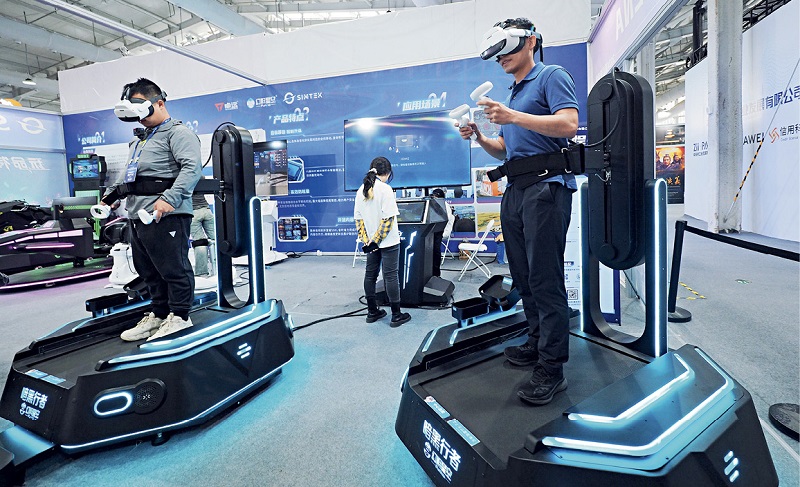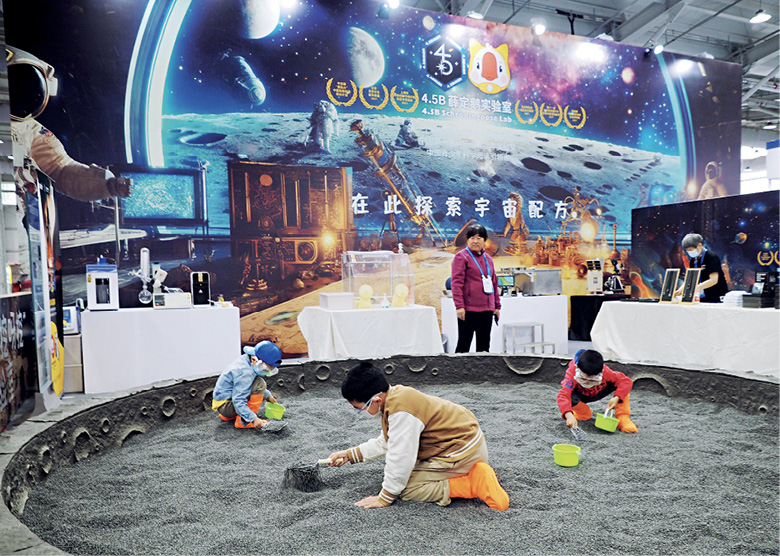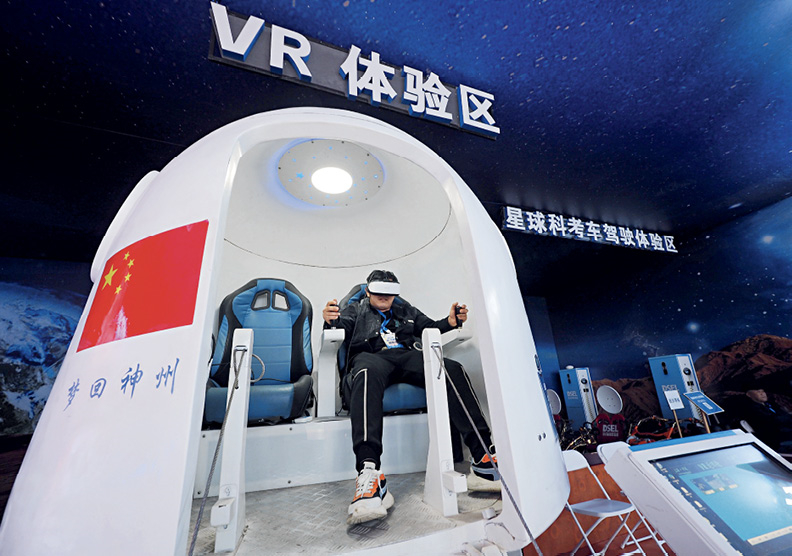
Visitors try out the VR treadmill at the Trendy and Fantasy Season of the 2024 CSFC on April 28, 2024.
Inside the main venue of the eighth China Science Fiction Convention (CSFC) in Beijing, a dozen primary school students were seen squatting in a huge artificial “lunar soil pit” wearing gloves and goggles, digging with their small shovels while a steady stream of visitors passed by.
“Here inside the pit is a lunar soil sample of national standard which we jointly developed with the Key Laboratory of Earth and Planetary Physics, Chinese Academy of Sciences, last year. Based on the lunar soil collected by China’s Chang’e-5 lunar probe in 2020, our researchers simulated the lunar surface,” said Yu Bin, a manager of the Schrodingoose Lab, a company dedicated to promoting science education among children.
At the convention in Shougang Park, Shijingshan District, from April 27 to 29, scientists simulated the moon surface based on their scientific research results, and allowed children to dig on the “moon” for all kinds of gems buried in the lunar soil.
“While the children play, our workers educate them about space, telling them why we need to go to the moon and how we are going to do it. The children ask a lot of questions. In this way, it is easier for them to understand and digest knowledge about space. A lot of science popularization nowadays is spoon-fed, but we hope to stimulate their scientific enthusiasm from within,” said Yu.
The exhibition area of more than 8,000 square meters attracted research institutions and exhibitors along the industrial chain, including the Deep Space Exploration Lab, Yuanyu Science Fiction and Future Technology Research Institute, and Guangzhou Dongjing Computer Technology Co., Ltd. University students from Beihang University and Beijing Institute of Technology, and primary and middle school students, as well as science fiction enthusiasts gathered at the convention.
A sideline event of the annual Zhongguancun Forum (ZGC Forum), the China Science Fiction Convention 2024, under the theme of “Scientific Dreams, Creating the Future,” featured 18 activities that were spread across four sections, including the opening ceremony, forum meetings, industry promotion activities and a science fiction film week, to bring a visual feast of “technology + imagination” to visitors. The convention not only focused on the innovative applications of current cutting-edge technologies in science fiction, culture, art, and other fields, but also set up many booths for ordinary attendees to experience the charm of it in an immersive way.

Children experience a simulated lunar soil excavation at the Trendy and Fantasy Season of the 2024 CSFC on April 28, 2024.
 Fun Science Experiments
Fun Science ExperimentsIn order to give visitors an immersive experience, the simulated lunar soil that appeared in the “lunar soil pit” at the convention was specially shipped via large trucks from Ulanqab in Inner Mongolia Autonomous Region, over 300 kilometers away from Beijing, by scientific researchers.
“Together with scientists from the Chinese Academy of Sciences, we’ve found the youngest volcanic basalt in the volcanos near Ulanqab that is closest to the sample collected by Chang’e-5 from the moon. We went there several times, collected it, and brought it back as experimental soil. We transported six tons of the soil for the ‘lunar soil pit’ here at the site,” said Yu further.
In addition to the game of treasure hunt from lunar soil, Yu also brought the 4.5B interstellar laboratory he designed to popularize space science and aerospace science knowledge among primary and secondary school students.
The 4.5B interstellar laboratory showed visitors a core technology in 6G era – terahertz radar technology. With a high frequency of above 100 MHz, it is mainly used to further analyze the structure of outer space materials. According to research, terahertz makes it possible to make a more complete analysis of the structure of substances compared with traditional methods, helping humans better understand the universe. Meanwhile, this technology is also expected to be used in broader fields, such as healthcare. One day in the future, people might be able to use it to monitor their electrocardiogram, blood pressure, and blood sugar without wearing any equipment. In the distant future, it can even be used to measure movement at a cellular level, such as the movement of cancer cells.
Apart from the “lunar soil pit,” there was more to see about the moon landing at this year’s convention. A superconducting magnetic levitation test was set up at another booth. A worker poured liquid nitrogen on the superconductor and lowered the temperature to minus 196 degrees Celsius, simulating the extremely low temperature environment on the lunar surface. The cooled superconductor was then placed on a magnet track, and the crowd saw it levitate and move forward rapidly. An experiment of this nature laid the foundation for high-efficiency transportation with extremely low energy and minimal wear and tear on the moon in the future.
In terms of scene design, there were also augmented reality scripted games and virtual reality interactive experiences, providing the audience with an immersive journey of planet exploration, like the super popular scientific research ship on the “surface of Mars.” The simulated bumpy driving brings everyone a driving experience close to that on the surface of Mars. In addition, there were also interstellar post offices and interstellar supply stations to popularize science in a more vivid way to the public.
In the eyes of Duan Ran, project operations director for the exhibition, each booth was dedicated to opening the door to science for general audiences, especially Chinese teenagers, so as to provide them a journey from fantasy to science. In her view, science fantasy was the predecessor of science. As human beings first have dreams before they transform them into reality, planting science dreams in children’s hearts is the first step to encourage them to embrace scientific exploration and become top scientists.
As an important section of the eighth China Science Fiction Convention, the 2024 Trendy and Fantasy Season included four major theme sections: popular science fiction and science education, science fiction technology, science fiction literature, and science fiction cultural and creative market, gathering more than 40 technology exhibitors.
Space Mission Accepted
“Welcome to the space rescue team, we will face a challenge in space. A few days ago, the space biological base encountered a super strong solar storm, causing damage to many facilities and serious deviation of the orbit. Once the space virus in the base is leaked to the Earth, it will bring catastrophe to humankind. Your task is to drive the return capsule, dock it with the space station, enter the biological base, and restart the control system. Are you ready? The return capsule is about to enter orbit.” Jia Zhuo, director of the Science Fiction Research Base at ZGC Science Fiction Industry Innovation Center, announced a mission to participants.
The ZGC Science Fiction Industry Innovation Center, located in Shougang Park, has an immersive science fiction experience hall. The simulated return capsule inside is not only of almost equal proportions to the real thing, but also has all the details, from the internal instruments and equipment to the cosmic scenery outside the window.
To complete the rescue mission, it is necessary to first enter the return capsule, then lift off, complete the docking in the air, and enter the space station. During the experience, visitors will find that the process of manually docking a spacecraft requires not only professional knowledge, but also many meticulous maneuvers, which is a test of skill and patience.
According to the China Manned Space Engineering Office, after entering orbit, the Shenzhou-18 manned spacecraft successfully docked at the radial port of the Tianhe core module of the space station at 3:32 on April 26, 2024. The entire automated rendezvous lasted approximately 6.5 hours. The breakthrough in China’s docking technology made those who experienced it marvel at China’s development in space technology.
The ZGC Science Fiction Industry Innovation Center also serves as a platform for the development of China’s science fiction industry. On the afternoon of April 27, as one of the important forum activities of the convention, the 2024 China Science Fiction Research Center Annual Meeting and Achievements Conference was successfully held in Shougang Park, and the Chinese Science Fiction Overseas Communication Report 2018-2023 was released. The report noted that as Chinese culture went global, the global spread of Chinese science fiction, as exemplified by the works of Liu Cixin, is diversified, interconnected, and multi-dimensional. With its growing influence, China’s science fiction is becoming a newly emerging cultural force around the world.

A visitor is operating a “return capsule” at the Trendy and Fantasy Season of the 2024 CSFC in the Shougang International Convention and Exhibition Center on April 28, 2024.
 Incredible Steel Art
Incredible Steel ArtThis year’s science fiction convention also had a session displaying sci-fi derivative cultural and creative products, which not only created a must-visit destination for sci-fi enthusiasts, but also a communication and trading platform for sci-fi enterprises along the industrial chain.
“We adopted a completely market-oriented operation model to organize the exhibition, adding something that is more accessible to the public, such as science fiction literature, science fiction film and TV shows, and science fiction derivatives. Visitors can experience the charm of science fiction first-hand. We also help companies go from visiting exhibitions to participating in exhibitions and building business from Shijingshan District,” said Duan.
What particularly attracted attention was the booth displaying the Shougang silk steel and cicada-wing steel artworks. Steel has always given people the impression of being tough and unyielding, and steel as thin as silk or cicada wings only existed in science fiction imagination in the past. Nowadays, China has broken through many scientific and technological problems to make such steel a reality.
“Silk steel” is made from more than 10 kinds of elements at the high temperature of 1,600 degrees Celsius. After a complex process, the elements are transformed into an electrothermal alloy fiber with a diameter of only 0.01meter. The fiber is oxidation-resistant and tough at above 1,000 degrees Celsius. After the steel is made into silk-like thin threads, it is then blended into embroidery threads of various colors, which will be interwoven into all manner of arts and decorations.
At the booth, visitors could view silk-like steel wire up close, witness its “lightness, thinness and softness” and learn about its manufacturing process. The experience shattered people’s inherent understanding of heavy, hard steel being transformed into silk-like works of art after hi-tech processing.
Since 2018, Shougang Jingtang United Iron & Steel Co., Ltd. has successfully produced ultra-thin steel plates with a thickness of only 0.08 millimeter, which are widely used in hi-tech fields, such as 5G equipment. “Cicada wing steel” represents Shougang’s achievements in the field of ultra-thin steel technology. The series of Bing Dwen Dwen postcards made of “cicada wing steel” and launched in 2023 also represent the century-old industrial upgrading and green and sustainable development of Shougang Park, which used to be a big steel mill.
With a variety of activities from sci-fi cultural and creative markets, sci-fi reading corners, sci-fi living room and others, the convention, seeing the development of science fiction industry as an opportunity, opened up a new life of imagination for on-site and online visitors to experience incredible technological changes. It is hoped to not only promote Beijing as an international science fiction hub, but also boost high-quality development of the science fiction industry in China.